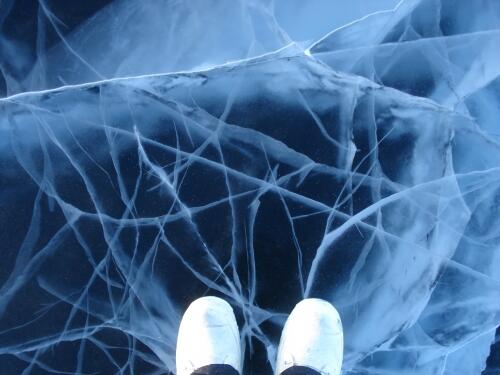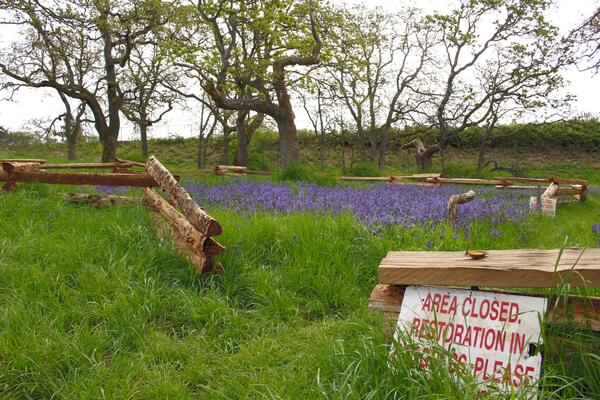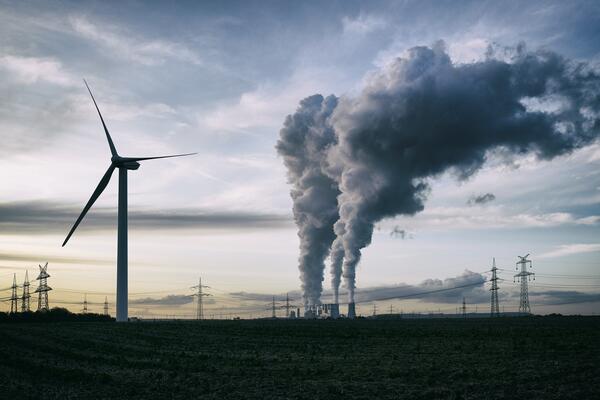Arctic lakes have been freezing up later in the year and thawing earlier, creating a winter ice season about 24 days shorter than it was in 1950, a University of Waterloo study has found.

Researcher Claude Duguay stands on the cracked ice of an Arctic lake
(Credit: Claude Duguay/University of Waterloo) Download image
The research, sponsored by the European Space Agency (ESA) and published in The Cryosphere, also reveals that climate change has dramatically affected the thickness of lake ice at the coldest point in the season: In 2011, Arctic lake ice was up to 38 centimetres thinner than it was in 1950.
“We’ve found that the thickness of the ice has decreased tremendously in response to climate warming in the region,” said lead author Cristina Surdu, a PhD student of Professor Claude Duguay in Waterloo’s Department of Geography and Environmental Management. “When we saw the actual numbers we were shocked at how dramatic the change has been. It’s basically more than a foot of ice by the end of winter.”
The study of more than 400 lakes of the North Slope of Alaska, is the first time researchers have been able to document the magnitude of lake-ice changes in the region over such a long period of time.
“Prior to starting our analysis, we were expecting to find a decline in ice thickness and grounded ice based on our examination of temperature and precipitation records of the past five decades from the Barrow meteorological station,” said Surdu “At the end of the analysis, when looking at trend analysis results, we were stunned to observe such a dramatic ice decline during a period of only 20 years.”
The research team used satellite radar imagery from ESA to determine that 62 per cent of the lakes in the region froze to the bottom in 1992. By 2011, only 26 per cent of lakes froze down to the bed, or bottom of the lake. Overall, there was a 22 per cent reduction in what the researchers call “grounded ice” from 1992 to 2011.
Researchers were able to tell the difference between a fully frozen lake and one that had not completely frozen to the bottom, because satellite radar signals behave very differently, depending on presence or absence of water underneath the ice.

Graph showing the reduction in grounded ice between 1992 and 2011
(Credit: Planetary Visions / University of Waterloo, Canada / ESA) Download image.
Radar signals are absorbed into the sediment under the lake when it is frozen to the bottom. However, when there is water under the ice with bubbles, the beam bounces back strongly towards the radar system. Therefore, lakes that are completely frozen show up on satellite images as very dark while those that are not frozen to the lake bed are bright.
Researchers used the Canadian Lake Ice Model (CLIMo) to determine ice cover and lake ice thickness for those years before 1991, when satellite images are not available.
The model simulations show that lakes in the region froze almost six days later and broke up about 18 days earlier in the winter of 2011 compared to the winter of 1950. Shorter ice-cover seasons may lead to shifts in lake algal productivity as well as thawing of permafrost under lake beds.
“The changes in ice and the shortened winter affect Northern communities that depend on ice roads to transport goods,” said Surdu. “The dramatic changes in lake ice may also contribute to further warming of the entire region because open water on lakes contribute to warmer air temperatures, albeit to a lesser extent than open sea water.”
The ice regimes of shallow lakes were documented using radar images from ESA’s ERS-1 and -2 satellites. More information on the ESA is available online.










